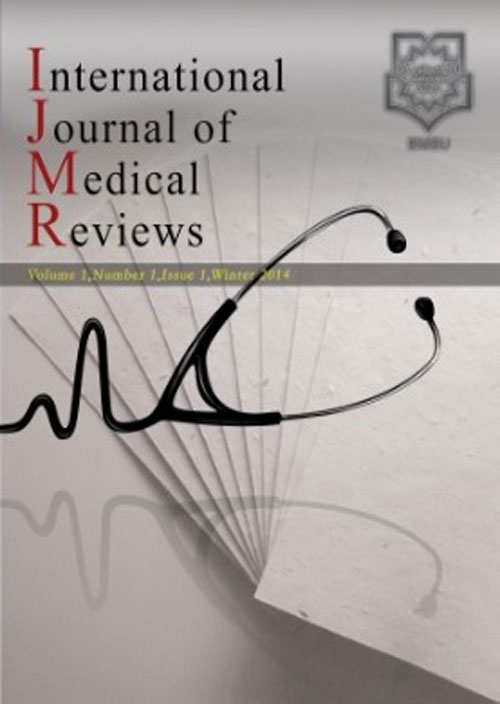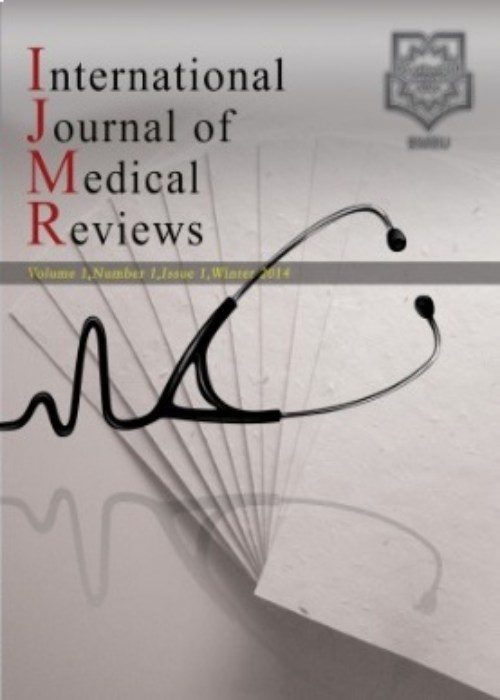فهرست مطالب

International Journal of Medical Reviews
Volume:8 Issue: 2, Spring 2021
- تاریخ انتشار: 1400/04/20
- تعداد عناوین: 7
-
-
Pages 57-64BackgroundLeukemia and lymphoma account for the leading cause of death worldwide and in Iran. Numerous studies have been conducted with various results in different regions of Iran. The largest study was conducted on 18,353 lymphoma cases in Iran during 2003-2008. The present study aimed to gather a higher level of evidence for an aggregated 1,478,583 cases of leukemia and lymphoma.ObjectiveRisk factors and etiology of leukemia and lymphoma are variable in different parts of the country; therefore, identifying them is essential for prevention and better management.MethodThe present study is a systematic review and meta-analysis to indicate the risk factors and to estimate the incidence of leukemia and lymphoma in Iran. All databases, including PubMed, Scopus, Springer, Cochrane, Google Scholar, were searched between 1970 and 2016. Out of the 152 selected articles in the preliminary search, 15 articles were reviewed, and the results of 11 studies were finally combined using the random-effects meta-analysis approach. The meta-regression and I₂ statistic were used to assess the heterogeneity. Data analysis was performed using STATA 12 software.ResultsIn addition to non-modifiable risk factors, modifiable risk factors are effective in the development of the disease. The incidence and overall prevalence of leukemia and lymphoma in Iran were estimated to be 3.26% (95% confidence interval: 2.7%-3.7%) and 7.15% (95% confidence intervals: 5.92%-8.37%), respectively.ConclusionIt can be stated that there is an increasing rate of hematologic cancers in Iran. This increase may be due to enhanced reporting and the presence of modifiable risk factors.Keywords: Epidemiology, Prevalence, Incidence, Leukemia, Lymphoma, risk factors
-
Pages 65-69
Glomerular crescents may be observed in conditions other than typically rapidly progressive glomerulonephritis such as antiglomerular basement membrane disease, pauci-immune glomerulonephritis and lupus nephritis. Data on extracapillary glomerulonephritis (ECGN) in diabetic patients are limited. In this study, we have discussed whether ECGN in diabetic patients is an independent or anatomo-clinically associated with diabetes.The presence of glomerular crescents in a diabetic patient can sometimes be clearly attributed to an independent classic cause. Diabetic Nephropathy seems to be a possible cause. The pathogenesis of crescent formation in diabetic nephropathy is unknown. In most cases, the renal prognosis is pejorative despite aggressive immunosuppressive therapy. The presence of crescent in a diabetic patient without any clear cause may represent a variant phenotype of diabetic nephropathy which leads to rapid decline in Glomerular Filtration Rate and ultimately to EndStage Renal Disease. There are still several limitations to the current studies, such as the small sample sizes, which tend to give inadequate representation; making them more hypothesis-generating than confirmatory. Large clinical and immunopathological studies with a broad spectrum of disease severity will be required to ascertain whether such presentations represent a distinct pathogenic phenotype of DN. Exploring the relationship between crescent formation and diabetic glomerulosclerosis is needed to completely uncover the mechanism of the non-inflammatory crescent formation.
Keywords: Diabetes, Extracapillary, Crescent, Glomerulonephritis, Kidneys -
Pages 70-73
Fibrin-rich plasma is a material that is easy to make, requires only the patient's blood, thus nullifies the chances of contamination and reduces the risk of infection. Its aspects of hemostasis and support of the immune system contribute to its satisfactory result. L-PRF has wide applicability, from dentistry to medicine, with excellent results in short and medium terms.Several studies have shown safety in its use for maxillofacial application. This study aims to make a brief review of the literature in the last 15 years regarding the use of L-PRF and its applicability in dentistry in general.
Keywords: Platelet- Rich Fibrin, Surgery Oral, Bone, Bone regeneration -
Pages 74-79
Young women from Sub-Saharan Africa are at substantial risk of HIV acquisition. Data from UNAIDS suggests that 59% of new HIV infections in 2019 occurred in this population. Despite advances in HIV prevention and care, they remain at substantial riskmaking them a key population for control. In the present study we discuss the factors that put women from Sub-Saharan Africa at differential risk of HIV acquisition, and the possible impacts of the COVID-19 pandemic on HIV care and prevention on this population. The COVID-19 pandemic has brought unprecedented challenges for healthcare delivery, including HIV care, treatment and prevention. The indirect long-term effects of the pandemic may increase the vulnerability of young women to HIV infection. Statistical modelling studies predict increased HIV related deaths in excess of 500 000 in the next four years if services for testing and treatment are disrupted. Innovative ways of delivering prevention messages, HIV care, treatment and reducing new infections during and beyond the COVID-19 pandemic are warranted to protect young women from Sub-Saharan Africa.
Keywords: COVID-19, HIV, Prevention, Sub-Saharan African women Introduction -
Pages 80-86
The main aim of this study is having a deep look from different facets at an undesirable virus, COVID-19, which challenge people's life around the world. There is another crucial goal for this study and is providing a piece of brief COVID-19 information from molecular aspects to clinical. COVID-19 has launched terrible mortality in the world as an epidemiologists reported in different articles. Some prevention ways are provided for more security in this article with meticulous studies which have done by scientists. Complex pathogenicity of the virus, structure, it’s resemblance to SARS and MERS, and even easy transmission of the virus confused scientists to provide an efficient vaccine for humanity. Also, this tough situation of the virus required scientists to examine any effective medication on the small community of patients. In addition, there is a greatresemblance pathological features of COVID-19 to SARS and MERS coronavirus infection. Moreover, COVID-19 soldiers attack the lungs region which resulted in lung failure. Having a complete study on the variety of articles lead to have an exact conclusion that COVID-19 is a resistant virus which transmits easily person to person and targets the individual’s lung lead to lung failure. There is no exact treatment and even a lucrative vaccine for the virus yet.
Keywords: Virus Activation, Viruses, COVID-19 -
Pages 87-98
There is a growing deviated physicians' practice regarding laboratory requests due to fear of failing to notice something important, fear of being criticized by superiors for neglecting a test or not coping with the uncertainties related to diagnoses, and so-called defensive testing. This behavior was attributed to the health system culture of fear and the lack of transparency of the costs associated with such unnecessary health care services. A literature search was carried out on these topics: laboratory management, laboratory testing, test requesting, test ordering, physicians' ordering behavior, cost reduction, appropriateness and efficiency using evidence-based resources, including peer-review publications until 2019. The negative impact of defensive medicine practice exceeds the economic consequences and necessarily reduces the patient outcomes and the total quality of patient care. A consensus between experts that the root cause of defensive medicine began with the increasing number of medical malpractice lawsuits. In Saudi Arabia, malpractice claims increased by 416% between 2008 and 2013. Multiple solutions have been suggested for the problem of inappropriate laboratory testing and defensive testing, but no single approach has been widely adopted. Combined strategies proved to be more effective and more durable. Building a culture of trust inside the health system is increasingly perceived as a significant influence on health system functioning.
Keywords: malpractice, defensive medicine, laboratory investigation, lab test -
Pages 99-104IntroductionRecurrent miscarriage is one of the most common problems during pregnancy and one of these factors that has been recently studied by researchers is vitamin D deficiency in pregnant women. Therefore, this study was performed to compare vitamin D levels in women with recurrent miscarriage and women with normal pregnancies.MethodsThe present study is a descriptive-analytical and cross-sectional study conducted in 2020 on 120 pregnant women referred to infertility centers in Isfahan in two groups of women with at least one successful pregnancy and women with recurrent miscarriage. Vitamin D blood levels of women were extracted from the information in their file. Data were analyzedusing SPSS software.ResultsThe mean concentration of vitamin D in the case group was 19.92±5.07 and in the control group was 23.33±4.20 showing a statistically significant difference between the two groups (P <0.05). Mean vitamin D was also significantly different between the two groups in terms of the number of previous children, number of pregnancies, abortion, and stillbirth (P <0.05).ConclusionSerum vitamin D levels in women with recurrent miscarriage are lower than women with normal pregnancies. Therefore, low levels of vitamin D in the blood can be one of the causes of recurrent miscarriage in pregnant women.Keywords: Vitamin D, Pregnancy, Recurrent Miscarriage, Mothers, Hospitals


